To make a delicious turkey gravy, you'll need 1 cup of turkey drippings, 1/4 cup of flour, and 2 cups of turkey or chicken broth. Start by collecting the drippings and skimming off the excess fat. Whisk the flour into the warm drippings to create a roux. Slowly incorporate the broth, whisking until smooth. Simmer the mixture gently to enhance flavors, then season with salt and pepper to taste. Feel free to add herbs or a splash of wine for extra richness. With these simple steps, you can create a comforting sauce that complements your holiday feast spectacularly. More tasty tips await!
Key Takeaways
- Use 1 cup of turkey drippings, 1/4 cup flour, and 2 cups broth for a classic turkey gravy base.
- Start by skimming excess fat from the turkey drippings before incorporating flour to create a roux.
- Gradually whisk in broth to achieve a smooth consistency, simmering gently to enhance flavors.
- Season with salt and pepper, and consider adding herbs like thyme or rosemary for extra flavor.
- For richness, a splash of white wine or sherry can be added, and adjust thickness with additional broth if needed.
History
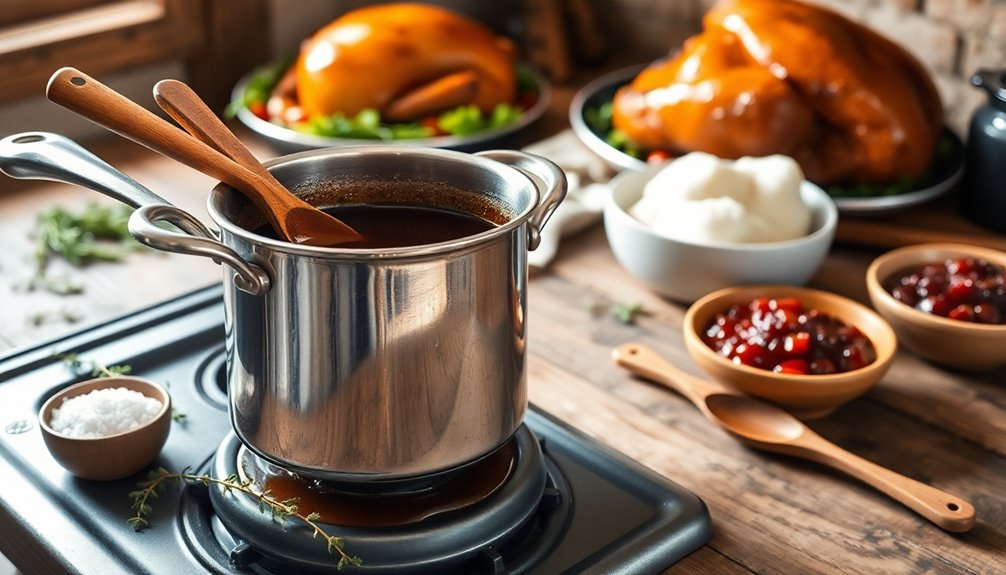
When you think about turkey gravy, you mightn't realize its rich history dates back centuries. This savory sauce likely originated from ancient civilizations, where cooks used meat drippings to create flavorful additions to meals.
As people began roasting turkeys, particularly in North America, gravy became a staple at festive gatherings. In colonial times, gravy was essential for making the most of limited resources, adding taste and moisture to otherwise dry dishes.
Over the years, regional variations emerged, incorporating local ingredients and culinary traditions. Today, turkey gravy symbolizes comfort and celebration, especially during holidays like Thanksgiving.
Understanding this history enhances your appreciation for the dish, connecting you to generations of cooks who've perfected the art of making it.
Recipe
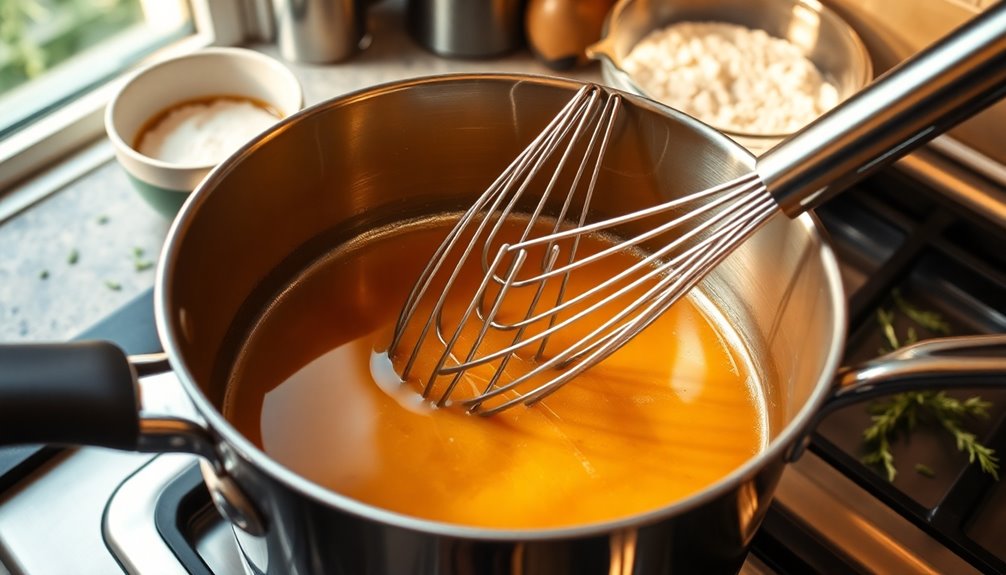
Turkey gravy is a delicious and essential accompaniment to your Thanksgiving feast or any festive meal featuring turkey. This rich, savory sauce is crafted from the drippings of the roasted turkey, which brings an incredible depth of flavor. The key is to use the pan drippings, which capture all the essence of the cooked turkey, combined with a few simple ingredients to create a smooth and velvety gravy that will elevate your meal.
To achieve the perfect turkey gravy, it's important to start with a solid base. The drippings are the heart of the gravy, so make sure to scrape up all the browned bits from the bottom of your roasting pan.
When cooked properly, the gravy won't only enhance the flavor of your turkey but will also complement mashed potatoes, stuffing, and any other side dishes on your table.
Ingredients:
- 1 cup turkey drippings
- 1/4 cup all-purpose flour
- 2 cups turkey or chicken broth
- Salt and pepper to taste
- Optional: herbs (like thyme or rosemary) for additional flavor
Cooking Instructions:
In a saucepan, pour the turkey drippings and place it over medium heat.
Whisk in the flour gradually to create a roux, stirring continuously until it turns golden brown.
Slowly add the turkey or chicken broth while continuing to whisk to prevent lumps.
Bring the mixture to a gentle simmer, allowing it to thicken for about 5-10 minutes.
Season with salt and pepper, and if desired, add herbs for extra flavor.
Extra Tips:
For an even richer taste, consider adding a splash of white wine or sherry to the drippings before you whisk in the flour.
If your gravy is too thick, you can thin it out by adding more broth or water until you reach the desired consistency.
Always taste your gravy before serving and adjust the seasoning as needed, since the saltiness of the drippings can vary.
Enjoy your homemade turkey gravy over your favorite dishes!
Cooking Steps
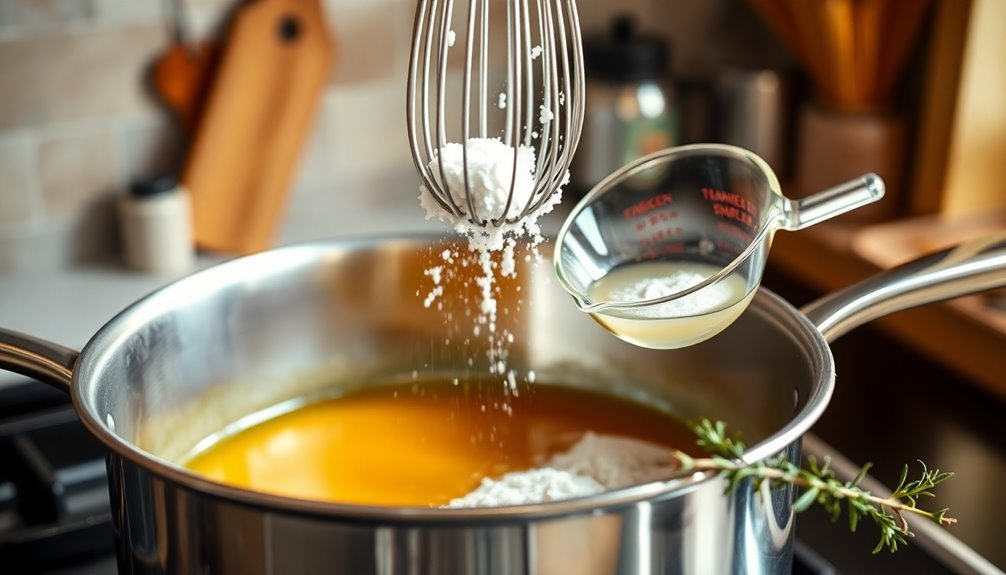
To make a delicious turkey gravy, you'll want to start with the drippings from your roasted turkey.
Once you have those ready, you can gradually add flour for thickening and whisk in broth for a rich flavor.
Don't forget to season it with salt and pepper to taste!
Step 1. Prepare Turkey Drippings First
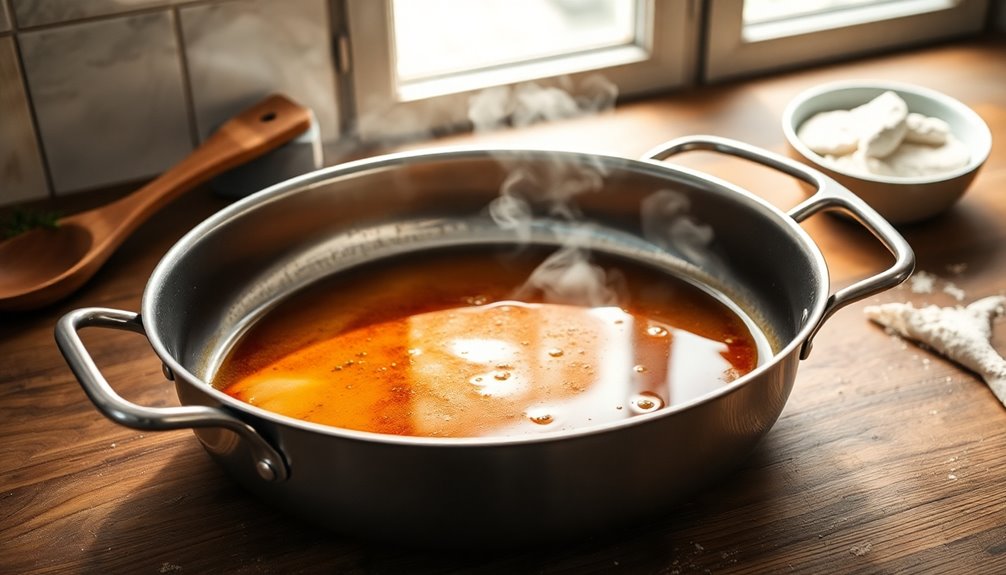
After you’ve roasted your turkey, the flavorful drippings left in the pan are essential for making a rich gravy. To create the gravy, begin by deglazing the pan with some broth or wine, scraping up any browned bits for extra depth of flavor. Once the liquid has reduced slightly, whisk in flour or cornstarch to thicken it to your desired consistency. If you’re also preparing a meal with a pork roast, be sure to follow the pork roast cooking instructions to ensure that every element of your meal is perfectly cooked and complements the rich gravy you’ve made.
Start by carefully pouring the drippings into a measuring cup or bowl. Let them sit for a few minutes so the fat rises to the top. Use a spoon or a turkey baster to skim off the excess fat, but don't discard it just yet; you'll need a bit of that fat for your gravy.
If you have more than a cup of drippings, you may want to save some for another dish.
Next, you can incorporate any browned bits stuck to the pan by scraping them with a wooden spoon, adding even more depth to your gravy's flavor.
Step 2. Add Flour for Thickening

Now that you've prepared your turkey drippings, it's time to thicken that delicious goodness. Start by measuring about ¼ cup of all-purpose flour.
In a separate bowl, whisk the flour with a bit of the warm turkey drippings to create a smooth paste. This will help prevent clumps in your gravy.
Once you've got a lump-free mixture, slowly pour it back into the pot with the remaining drippings, stirring constantly. Keep stirring as you cook over medium heat; this will activate the flour and help it thicken.
You'll notice the gravy starting to take shape in just a few minutes. If it's not as thick as you'd like, you can always add a bit more flour mixture to reach your desired consistency.
Step 3. Simmer for Flavor Enhancement
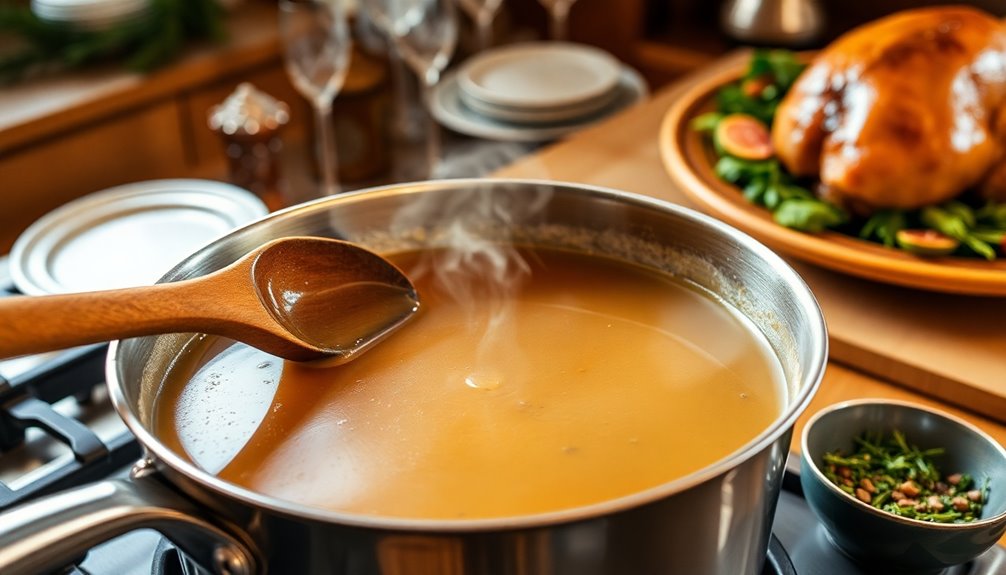
As the gravy thickens, let it simmer gently to enhance the flavors. This step is essential for developing a rich, savory profile.
Keep the heat low, allowing the gravy to bubble softly. Stir occasionally to prevent sticking and guarantee even cooking. You'll notice the aromas becoming more pronounced as the ingredients meld together.
Aim to simmer for about 15 to 20 minutes, which gives the flavors time to deepen. If the gravy gets too thick, you can add a splash of water or stock to reach your desired consistency.
Taste it occasionally and adjust the seasoning as needed. A perfect simmer will elevate your turkey gravy, making it a delicious complement to your holiday feast.
Step 4. Whisk in Broth Gradually

Gradually whisk in the broth to create a smooth, velvety texture in your turkey gravy.
Start by pouring in a small amount of broth, about half a cup, while continuously stirring. This helps to prevent lumps from forming.
Keep whisking until the mixture is well combined and begins to thicken. Once you achieve a consistent texture, continue adding the broth in increments, whisking after each addition.
Pay attention to the gravy's thickness; you can adjust the amount of broth based on your preference. If it gets too thick, don't hesitate to add a little more broth.
This gradual process guarantees your gravy turns out perfectly creamy and delicious, enhancing your turkey dinner experience.
Step 5. Season With Salt and Pepper
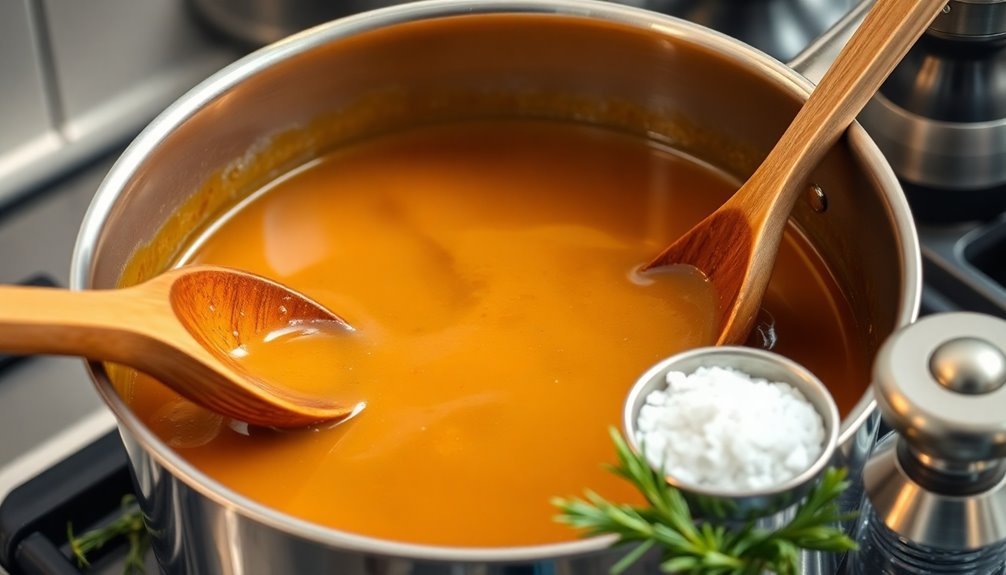
Once your gravy has reached the desired consistency, it's essential to season it with salt and pepper to enhance its flavor.
Start by adding a pinch of salt; you can always add more later, but you can't take it out. Stir well and taste the gravy. If it feels flat, sprinkle in a bit more salt.
Next, add freshly cracked black pepper to taste. This will add a nice kick and depth to your gravy. Mix everything thoroughly and taste again—this is your chance to adjust.
If you want to elevate the flavor even more, consider adding a splash of Worcestershire sauce or a hint of garlic powder.
Once you're satisfied, your gravy is ready to serve!
Final Thoughts
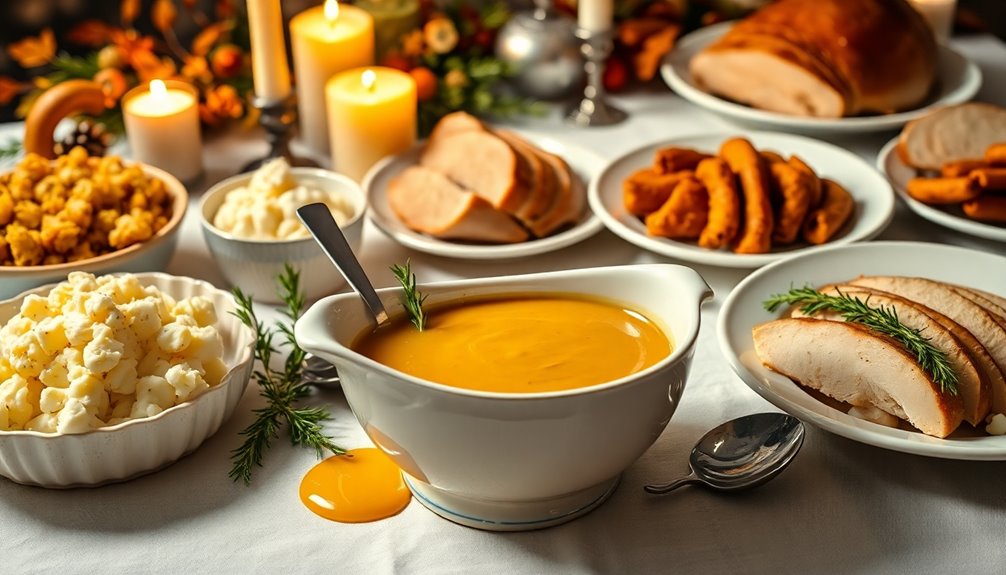
While you may have your go-to recipes for holiday meals, mastering a delicious turkey gravy can elevate your dining experience.
It's the perfect complement to your turkey, adding richness and depth to your plate. Don't be afraid to experiment with flavors, whether it's incorporating herbs or a splash of wine.
Remember, practice makes perfect—so don't worry if your first attempt isn't flawless. Each time you make gravy, you'll grow more confident in your skills.
Pair it with your favorite sides, and you'll impress your guests. So, roll up your sleeves, grab those drippings, and get started.
With a little patience and creativity, you'll create a mouthwatering turkey gravy that everyone will rave about for years to come. Enjoy every bite!
Frequently Asked Questions
Can I Make Turkey Gravy Ahead of Time?
Yes, you can definitely make gravy ahead of time!
In fact, preparing it in advance can save you a lot of stress on the big day. Just cook your gravy, let it cool, and store it in an airtight container in the fridge.
When you're ready to serve, simply reheat it on the stovetop, adding a splash of broth if needed to get the right consistency.
You'll appreciate the extra time you gain!
How Do I Store Leftover Turkey Gravy?
To store leftover gravy, let it cool to room temperature before transferring it to an airtight container.
You can refrigerate it for up to four days. If you want to keep it longer, freeze the gravy in a freezer-safe container or a resealable plastic bag, making sure to leave some space for expansion.
When you're ready to use it, thaw it in the fridge overnight and reheat on the stove, stirring frequently.
Can I Freeze Turkey Gravy?
Yes, you can freeze turkey gravy! It's a great way to save leftovers for later use.
Just let the gravy cool completely before transferring it to an airtight container or freezer bag. Make sure to leave some space at the top, as it will expand when frozen.
When you're ready to use it, thaw it in the fridge overnight and reheat it on the stove, stirring occasionally for a smooth consistency.
What Can I Use Instead of Turkey Drippings?
If you don't have turkey drippings, you've got plenty of options!
You can use chicken or beef broth as a base, adding some sautéed onions and garlic for flavor. A mixture of butter and flour can create a roux, thickening your gravy just right.
Additionally, consider incorporating soy sauce or Worcestershire sauce for depth. Don't forget herbs like thyme or rosemary to enhance the taste!
Enjoy experimenting with flavors that suit your meal.
How Can I Thicken My Turkey Gravy?
To thicken your gravy, you can use a few simple methods.
One popular option is to create a slurry by mixing equal parts cornstarch and cold water, then whisk it into your gravy.
Alternatively, you can make a roux by cooking equal parts flour and fat until golden, then adding it to your gravy.
Simmer for a few minutes until it reaches your desired consistency.
Adjust seasoning as needed, and enjoy your rich, thick gravy!










